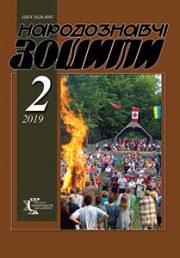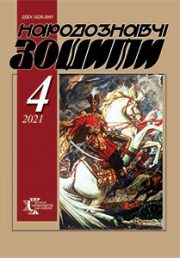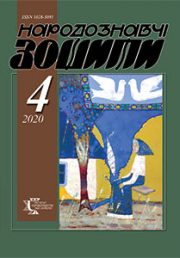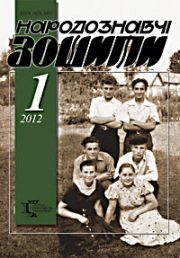The Ethnology Notebooks. 2021. № 3 (159), 641—658
DOI https://doi.org/10.15407/nz2021.03.641
LITERARY STUDIES OF HRYHORIY DEMYAN
KOVAL Halyna
- ORCID ID: http://orcid. org/0000-0002-2998-2357
- Candidate of Philology, Senior Researcher
- The Ethnology Institute National Academy of Sciences of Ukraine
- Department of Folklore,
- Lviv-center, 15 Svobody ave,
- 79000, Lviv City
- Contacts: e-mail: galyna.kov@gmail.com
Abstract. The article deals with the research of H. Demyan in the field of Ukrainian literary criticism. This is his most active period in the 1970s and 1990s, which covered a huge amount of material that introduces the activities of a whole cohort of people of the artistic word, literary trends, and styles.
The subject of the study was explorations on the elocutionists of the XIX—XX centuries, which examines the life and creative development of many writers, literary critics. From there you can learn about artistic and cognitive activities, trace logical concepts and ideas. The peculiarity of these publications is that almost each of them has a certain relationship to local history or contains information about the national scale of a person.
Here are a number of explorations about various figures. First of all, we are talking about one of the oldest representatives of Boykivshchyna, L. Dankevych — a priest, poet, fable writer, publicist. I. Franko who passed through the «Boyko plains» and left noticeable traces in his work, deserved special attention. Brothers Bohdan and Pavlo Kyrchiv made a significant contribution to the literature. The activity of writers and public and cultural figures from the Stryj region O. Bobykevych, V. Byrchak and translator D. Yosyfovych. An important role was given to Bukovynian writers — Yu. Fedkovych, S. Vorobkevych, I. Bazhanskyi, D. Makogon and I. Wilde. The work of women in literature such as E. Bohenska, E. Yaroshynska, K. Malytska, O. Kobylyanska, is highly appreciated. As a separate edition, H. Demyan published works by E. Bohenska and K. Malytska. The list of young writers was replenished with the names of V. Matiyiv, Ya. Sachko, and literary critic S. Kiral.
Such a wide representation of creative people in the literary field became a guarantee to show the achievements of H. Demyan in this field, to identify the principles of selection and methods of work on this material, to give a professional assessment of scientific approaches, as literature is one of the arts — a special form of public consciousness which is based on the figurative reproduction of reality. This made the chosen topic relevant.
The source base for writing the proposed exploration were articles published in various periodicals, separate collections of works by writers, archival materials stored in the Manuscripts Department of the Lviv National Scientific Library named after V. Stefanyk, home archive of H. Demyan.
Keywords: literary studies, writer, poet, translator, public and cultural figure.
Received 20.04.2021
REFERENCES
- Dem’yan, H. (1968). My foothills are green. October (Vol. 4, pp. 113—117; Vol. 5, pp. 135—138) [in Ukrainian].
- Dem’yan, H. (1991). Talents of Boykivshchyna (Pp. 9—166). Lviv: Kamenyar [in Ukrainian].
- Dem’yan, H. (1995). Golden din. Literary and artistic Stryj region. Stryi waves (Pp. 236—295). Stryi: Shchedrik [in Ukrainian].
- Ogonovsky, O. (1889). History of Russian literature (Book 1, pp. 349—350). Lviv [in Ukrainian].
- Dem’yan, H. Luka Dankevich. Talents of Boykivshchyna (P. 69) [in Ukrainian].
- Dem’yan, H. (1995). Golden din. Luka Dankevich. Stryi waves (P. 255) [in Ukrainian].
- Dem’yan, H. (1973, 1 february). Mykola Ustiyanovych and Skolivshchyna. Soviet Verkhovyna [in Ukrainian].
- Dem’yan, H. (1986, 27 december). In the memory of the people. To the 175th anniversary of the birth of ML Ustiyanovich. Victory flag. Zastavna [in Ukrainian].
- Franko, I. (1982). Literary language and dialects. In Ivan Franko. Zibrannia tvoriv: u 50 t (Vol. 37, p. 209). Kyiv: Naukova dumka [in Ukrainian].
- Dem’yan, H. (1985, 15 october). He sought to rebuild the old world. To the 150th anniversary of the birth of FI Zarevich. Victory flag. Zastavna [in Ukrainian].
- Dem’yan, H. (1987, 12 september). Writer Fedor Zarevich from Slavske. Soviet Verkhovyna. Skole [in Ukrainian].
- Dem’yan, H. (1988). Founder and editor of «Vechernytsia». October (Vol. 7, pp. 109—112) [in Ukrainian].
- Dem’yan, H. Fedor Zarevich. Talents of Boykivshchyna (Pp. 78—106) [in Ukrainian].
- Dem’yan, H. Golden din. Fedor Zarevich (Pp. 261—272) [in Ukrainian].
- Dem’yan, H. (1984, 8 august). The strings of his zither ring. Stryi waves. To the 150th anniversary of the birth of Yu. Fedkovych. Soviet life. Kitsman [in Ukrainian].
- Franko, I. (1982). Preface [to the publication: Danylo Mlaka (Izidor Vorobkevych). Over the Prut]. In Ivan Franko. Zibrannia tvoriv: u 50 t. (Vol. 33, p. 114). Kyiv: Naukova dumka [in Ukrainian].
- Dem’yan, H. (1986, 15 may). Sidir Vorobkevych and Kitsman region. Soviet life. Kitsman [in Ukrainian].
- Dem’yan, H. (1965, 2, 3, 5 november). Great Stonemason and Stryi. To the 110th anniversary of the birth of I.Ya. Franko. Builder of communism. Stryi [in Ukrainian].
- Dem’yan, H. (1973, 25 october). Frankish ways. Soviet Verkhovyna. Skole [in Ukrainian].
- Dem’yan, H. (1982). Playa and valleys of Boykivshchyna. In the ways of Ivan Franko in Ukraine (Pp. 87—94). Lviv: Kamenyar [in Ukrainian].
- Dem’yan, H. Boykovsky plains of Ivan Franko. Talents of Boykivshchyna (Pp. 9—63) [in Ukrainian].
- Dem’yan, H. Golden din. Ivan Franko (Skolivshchyna, Stryjshchyna). Stryi waves (Pp. 236—253) [in Ukrainian].
- Dem’yan, H. Bogdan Kirchiv. Talents of Boykivshchyna (P. 106) [in Ukrainian].
- Dem’yan, H. (1988, 7 january). Poet Bohdan Kirchiv. Soviet Verkhovyna. Skole [in Ukrainian].
- Dem’yan, H. (1988, 7 april). Writer Paul Kirchiv. Soviet Verkhovyna. Skole [in Ukrainian].
- Dem’yan, H. Golden din: D. Kirchiv. Stryi waves. ( Pp. 273—278) [in Ukrainian].
- Dem’yan, H. Paul Kirchiv Talents of Boykivshchyna (Pp. 113—124) [in Ukrainian].
- Dem’yan, H. Bobykevych. Oleksiy Khrystoforovych. In Viddil rukopysiv L’vivs’koyi natsional’noyi naukovoyi biblioteky imeni V. Stefanyka. F. 207. Od. zb. 52 [in Ukrainian].
- Franko, I. (1981). Oleksa Bobikevich. In Ivan Franko. Zibrannia tvoriv: u 50 t. (Vol. 34, p. 371). Kyiv: Naukova dumka [in Ukrainian].
- Dem’yan, H. (1995, 21 september). «Tireless worker in the field of education…». The din of freedom. Stryi [in Ukrainian].
- Dem’yan, H. Golden din. Oleksa Bobikevich. Stryi waves (Pp. 288—289) [in Ukrainian].
- Bobikevich, O. (2000). Works. Lviv: Kamenyar [in Ukrainian].
- Dem’yan, H. (1990). Yosifovich Dmitry Grigorovich. Ukrainian literary encyclopedia. (Vol. 2, pp. 360—361). Kyiv: URE them. M.P. Bazhana [in Ukrainian].
- Dem’yan, H. (1985, 29 january). His translations were also read in Boykivshchyna. Lenin’s Way. Turka [in Ukrainian].
- Dem’yan, H. (1985, 8 february). Chekhov’s translator. Young Bukovinian [in Ukrainian].
- Dem’yan, H. (1987, 10 february). A talented translator. Victory flag. Zastavna [in Ukrainian].
- Dem’yan, H. Hitar of Skoliv district of Lviv region. In Viddil rukopysiv L’vivs’koyi natsional’noyi naukovoyi biblioteky imeni V. Stefanyka. F. 207. Od. zb. 77 [in Ukrainian].
- Dem’yan, H. (1988). Bohenskaya Eugenia Ivanovna. Ukrainian literary encyclopedia. (Pp. 225—226). Kyiv: URE them. M.P. Bazhana [in Ukrainian].
- Dem’yan, H. (2004). Bohenskaya Eugenia Ivanovna. Encyclopedia of modern Ukraine. (Vol. 3, p. 398) [in Ukrainian].
- Dem’yan, H. (1991). Cooperation of like-minded people (Volodymyr Hnatiuk and Yevhenia Bokhenska). The role of Volodymyr Hnatiuk in the development of Ukrainian national science. Abstracts of reports and reports of the scientific conference dedicated to the 120 th anniversary of the birth of Volodymyr Hnatiuk (Pp. 62—64). Ternopil [in Ukrainian].
- Bohenskaya, E., & Dem’yan, H. (Ed.). (2002). Writings. Lviv: Kamenyar [in Ukrainian].
- Petrash, O. (2004, 13 january). From the Franko galaxy. Free life. Ternopil [in Ukrainian].
- Dem’yan, G. (1974, 31 october). An outstanding writer. Victory flag. Zastavna [in Ukrainian].
- Dem’yan G. Eugenia Yaroshinchka. Victory flag. 1986. 4 March [in Ukrainian].
- Dem’yan G. Blessed fire. Victory flag. 1988. October 20 [in Ukrainian].
- Franko, I. (1980). Ukrainian literature in 1888. In Ivan Franko. Zibrannia tvoriv: u 50 t. (Vol. 27, p. 269). Kyiv: Scientific Opinion [in Ukrainian].
- Dem’yan, H. (Ed.). (1991). Little heroes: Stories for children among. school age. Lviv: Kamenyar [in Ukrainian].
- Sukhodub, Z. (1993). «Little Heroes» by Konstantina Moklytska. Bell (Vol. 4—6, p. 176) [in Ukrainian].
- Demyan, G. (1994). Bazhansky Ivan Mykolayovych. Art of Ukraine (Vol. 1, pp. 127—128). Kyiv: Ukrainian encyclopedia of Ukraine M.P. Bazhana [in Ukrainian].
- Demyan, G. (2002). Bazhansky Ivan Mykolayovych. Encyclopedia of modern Ukraine
- (Vol. 2, pp. 74—75) [in Ukrainian].
- Demyan, G. Touches to the biography of I.M. Bazhansky. In Viddil rukopysiv L’vivs’koyi natsional’noyi naukovoyi biblioteky imeni V. Stefanyka. F. 207. Od. zb. 42 [in Ukrainian].
- Demyan, G. Topics of articles and reports about O. Kobylyanska. In Domashniy arkhiv H. Dem’yana. Statti, povidomlennya, materialy (Vol. 10, arc. 97) [in Ukrainian].
- Demyan, G. (1987, 25 july). Olga Kobylyanska and Zastavnivshchyna. Victory flag. Zastavna [in Ukrainian].
- Demyan, G. (1988, 6 september). Flowers of sincere friendship. Victory flag. Zastavna [in Ukrainian].
- Demyan, G. (1988, 3 september). Kobylyanska’s friend from Slavsk. Soviet Verkhovyna. Skole [in Ukrainian].
- Demyan, G. (1989, 26 july). Familiar in every village. Victory flag. Zastavna [in Ukrainian].
- Demyan, G. (1988, 14 may). Writer Maria Ustiyanovych. Soviet Verkhovyna. Skole [in Ukrainian].
- Dem’yan, H. Maria Ustiyanovych-Bobykevych. Talents of Boykivshchyna (P. 124) [in Ukrainian].
- Dem’yan, H. Golden din. Maria Ustiyanovych-Bobykevych. Stryi waves (Pp. 285—286). Stryi [in Ukrainian].
- Demyan, G. (1988, 1 may). Creative relationships. Victory flag. Zastavna [in Ukrainian].
- Demyan, G. (1988). Bobykevych-Sora Klavdiya Izidorivna. Ukrainian literary encyclopedia (Pp. 198—199). Kyiv: URE them. M.P. Bazhana [in Ukrainian].
- Demyan, G. (1989, 12 march). Bobykevych-Sora Klavdiya Izidorivna. Young Bukovinian [in Ukrainian].
- Demyan, G. (2004). Bobykevych-Sora Klavdiya Izidorivna. Encyclopedia of modern Ukraine (Vol. 3, p. 91) [in Ukrainian].
- Demyan, G. (1989, 21 october). Birchak Vladimir. Red flag [in Ukrainian].
- Demyan, G. (1995, 21 october). Golden violin. The din of freedom. Stryi [in Ukrainian].
- Demyan, G. Golden din. Vladimir Birchak. Stryi waves (Pp. 289—291). Stryi [in Ukrainian].
- Dem’yan, H. Iryna Levynska. Talents of Boykivshchyna (Pp. 142—143) [in Ukrainian].
- Dem’yan, H. (1976, 19 february). A real literary holiday. Victory flag. Zastavna [in Ukrainian].
- Dem’yan, H. (1975, 21 december). Iryna Wilde in Verenchanka. Young Bukovinian [in Ukrainian].
- Dem’yan, H. (1981, 5 november). Anniversary of the writer. Victory flag [in Ukrainian].
- Dem’yan, H. (2001). Writers Dmytro Makogon and Iryna Wilde worked in the UVO and the OUN. The way of liberation (Vol. 10, pp. 75—82) [in Ukrainian].
- Dem’yan, H. From under Makivka — to science. [Memoirs. Diaries. Reviews and more]. In Domashniy arkhiv H. Dem’yana (Ark. 128—141) [in Ukrainian].
- Dem’yan, H. Vladimir Matiyev. Talents of Boykivshchyna (P. 158) [in Ukrainian].
- Dem’yan, H. Yaroslav Sachko. Talents of Boykivshchyna (Pp. 162—166) [in Ukrainian].
- Dem’yan, H. (1988, 15 december). Literary critic S. Kiral. Soviet Verkhovyna. Skole [in Ukrainian].
- Dem’yan, H. Cider Kiral. Talents of Boykivshchyna (Pp. 260—263) [in Ukrainian].







